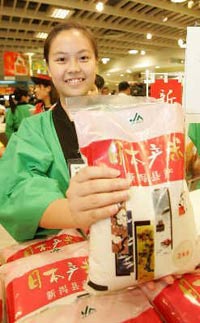|
|

|
|
A sales person shows a bag of Japanese rice in her hand in a supermarket of China in an undated file photo.The Japanese government has urged the nation to eat more rice in a new drive to boost the nation's self-sufficiency.
|
The Japanese government has urged the nation to eat more rice in a new drive to boost the nation's self-sufficiency.
Once the most important ingredient in every Japanese meal, the average amount of rice eaten each day has shrunk by more than 50 per cent over the past 40 years.
The government has now unveiled plans to boost rice consumption in a bid to drive up the nation's self-sufficiency rate from 40 to 50 per cent within the next decade.
The recommended consumption rate of rice as astaple food has also been increased from 61 to 63 kilograms per person a year, Shigeru Ishiba, the agriculture minister announced.
"This target can be achieved if Japanese people eat an additional bite of rice at every meal," said a ministry official.
Traditionally the focal point of every meal in Japan, rice has steadily been eclipsed by Western foods such as pasta and cereals.
The self-sufficiency initiative is the latest in a string of government drives to encourage the nation to revert back to its traditional rice roots.
Earlier this year, ministers launched a major Y200million campaign to woo back a new generation of rice eaters in a bid to revive the domestic rice industry.
Bakeries across the country were urged to make bread with rice flour, local government cookery classes taught housewives how to make rice pasta and thousands of schools were served rice-based food for lunch.
Further steps towards agricultural self-sufficiency included the doubling of wheat production to 1.8 million tones and soybean from 230,000 tonnes to 500,000 tonnes as well as further hikes in dairy and milk output.
The ongoing decline in rice consumption has also impacted the waistlines of the nation.
During the past three decades, Japanese men have grown in weight by ten per cent and women by 6.4 per cent, according to government figures.
Since 2002 the number of obese and overweight Japanese over the age of 15 has risen from 28 to 36 million, according to a recent report by Datamonitor, the international market research analysts.
点击查看更多双语新闻
(Agencies)
|
更多日本趣事
为提高本国的粮食自足率,日本政府日前鼓励国民多吃大米。
大米曾是日本人餐桌上最重要的食品,而在过去40年中,日本人的日平均大米消耗量减少了50%多。
为实现在未来十年将粮食自足率从40%提高至50%的目标,日本政府日前公布了提高大米消耗量的新计划。
据日本农业大臣太田诚一介绍,日本的年人均大米建议消耗量也从61公斤增长到了63公斤。
一位官员称:“只要人们每顿多吃一口米饭,这个目标就能实现。”
曾为日本人一日三餐必不可需食品的大米如今已逐渐被通心粉和谷类等西方食品所取代。
日本政府采用了一系列办法鼓励国民吃大米。自给自足计划是最新的措施。
今年早些时候,日本政府发起了一项耗资达2亿日元的“回归大米”运动,以振兴本国的大米业。
此外,政府还敦促全国各地的面点店用米面做面包,地方政府组织家庭主妇学习如何做米制通心粉,数千所学校的午餐也都开始以大米类食品为主食。
日本提高粮食自给率的其它举措还包括,粮食增产一倍,达到180万吨;大豆产量从23万吨增至50万吨;以及进一步提高奶制品和鲜奶产量。
大米消耗量的持续下降已经影响到日本人的体重。
据政府统计数据显示,在过去三十年中,日本男性的体重平均增长了10%,女性增长了6.4%。
据Datamonitor全球市场数据分析机构的一份最新报告显示,日本15岁以上的肥胖和体重超标人数从2002年的2800万增长到了现在的3600万。
(英语点津姗姗编辑)
|